Famous Egyptian Gods
Here is an alphabetical list of the 29 most important ancient Egyptian gods.
-
Amun - King of the Egyptian Gods
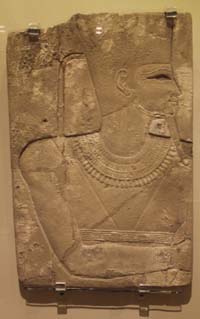
At first, Amun was a local deity worshipped in the city of Thebes. After the Pharaohs moved their capital to this city, his worship spread throughout the land of Egypt. Amun was the greatest of the sun gods. During the 18th Dynasty, the Egyptians combined Amun with Ra and he became the creative power that created all life. He had two consorts, Amunet and Mut and was part of the Thebes Triad with Mut and their son Khonsu. Some of Amun’s depictions show him as a man with a hawk’s head with a bull’s tail hanging from his tunic.
Click here to discover more about Amun
-
Anubis - God of Death

Anubis was the god of embalming and a god of the dead. He was the son of Nephthys and either Osiris or Seth but Isis raised him. Anubis’ depictions show him as either a man with a jackal’s head or as a jackal. He presided over funerals and guided the souls of the dead through the Tuat to Osiris’ kingdom. He also oversaw the ceremony where the gods weighed a human heart to make sure there was a fair judgment. Anubis became the god of embalming after he helped embalm and preserve Osiris’ body.
Click here to discover more about Anubis
-
Aten
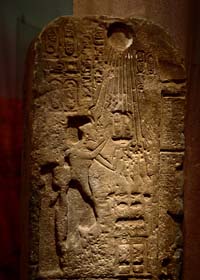
Aten was the sun god worshipped by Pharaoh Akhenaten and he comes from an unknown origin. Those hymns written to him that have survived show that his worship was a joyful experience. Aten had no humanoid shape; instead his depictions show him as a sun disc with rays extending from him that has hands on the end of each ray. Images of the royal family that show them worshipping Aten are at Tell el-Amarna, the site of Akhenaten’s capital city.
-
Atum
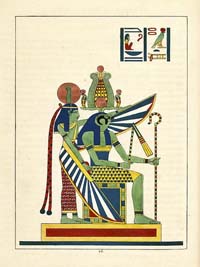
Atum was the oldest of the creations gods worshipped by the Egyptians and they thought he existed before anything else. He created Nun, the celestial waters, and everything else through his thoughts. Thoth was Atum’s intelligence and put his creative thoughts into words to bring them to life. In the Book of the Dead, Atum was the setting sun and his images show him as a human wearing the double crown of Egypt.
Click here to discover more about Atum
-
Bastet
Bastet, or Bast, was a cat goddess and the patroness of pregnant women. She loved music and dance which made her festival at Bubastis one of the most popular festivals in Egypt. According to records, her festivals had as many as 700,000 attendees. The Egyptians regarded Bastet as the personification of the sun’s beneficial powers. Her depictions show her as either a woman with a cat’s head or as a cat and people mummified cats in her honor.
Read more about the goddess Bastet
Read more about cats in ancient Egypt facts
-
Bes
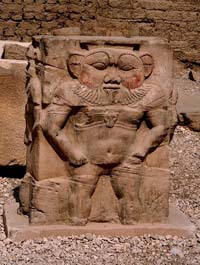
The ancient Egyptians believed that Bes possessed two distinct natures. He was the patron of art, childbirth and music but he was also a war god and a strangler of various animals, including lions. People placed Bes’ image above their headrests to ward off evil spirits. At first, his images show him as an ugly dwarf with a large head, thick arms and bowed legs. Later images show Bes as a handsome man after he became associated with Horus the Child.
-
Geb - God of the Earth
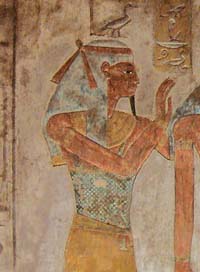
Geb was the personification of the earth and his consort was Nut. They were the parents of the five Osirian gods; Osiris, Isis, Horus, Nephthys and Seth. Geb’s symbol was the goose and some of his depictions show him as a man with a goose on his head. Other images show him as a man lying beneath Shu’s feet with Nut arched above them. In some of these images, Geb was green or black to represent the fertility of the earth.
Click here to discover more about Geb
-
Hapy
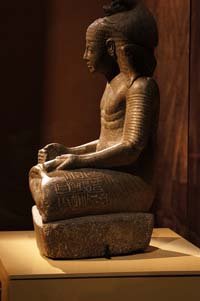
Hapy was the god of the Nile and the Egyptians associated him with the various primeval creation gods. Over time, the Egyptians came to regard him as the creator of everything. Hapy’s depictions show him holding a lotus and a papyrus to show his dominion over the entire Nile. His images show him as a fat man with female breasts to emphasize his fertility.
-
Hathor
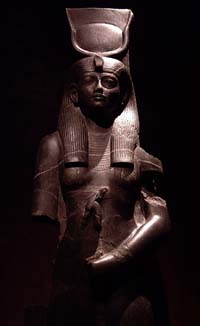
Hathor was a cow goddess and a great cosmic or mother goddess. Her name meant “House of Horus” and in some legends she was both the mother and consort of Horus. Myths claimed that Hathor gave birth to all life and nourished it through her milk. She also provided the dead in the Tuat with food and her main temple was at Dendera. Hathor’s depictions show her as a cow or a woman with a cow’s head or horns.
Click here to discover more about Hathor
-
Horus - The Egyptian Falcon God
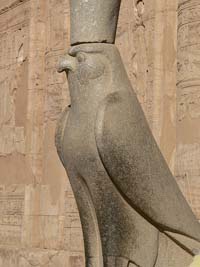
Horus was a sky god and one of the five Osirian gods. According to some legends his parents were Geb and Nut but other myths said his parents were Osiris and Isis. After Osiris’ murder, Horus fought Seth for the kingship of the gods and the Pharaoh was “the living Horus”. He was part of two divine triads; one with Osiris and Isis and another as Horus of Edfu with Hathor and Ihi. Horus’ depictions show him as a man with a hawk’s head topped by a solar disc encircled by the ureaus, a divine cobra.
Click here to discover more about Horus
-
Isis - The Goddess of Fertility

Isis was a mother goddess, a fertility goddess, the goddess of magic, and a healing goddess. She was one of the five Osirian gods and one of her titles was “the goddess with 10,000 names” because of all the roles and names she received. Isis’ worship spread throughout Egypt and the Greek and Roman empires. She played an important part in the journey of the dead because of her work to restore Osiris to life and preserve his body. The scorpion was her symbol and she was often shown with large wings. Isis’ images also show her nursing either Horus or the Pharaoh.
Click here to discover more about Isis
-
Khepri
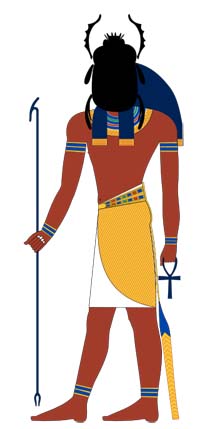
Khepri was the rising sun and he was a self-created, creator god. The scarab, a type of beetle, was his associated creature and the Egyptians wore scarab amulets to gain his protection. The Egyptians believed that the sun rolled across the sky like a scarab rolled balls of dung. Khepri’s depictions show him as a man with a scarab on his head, as a man with a scarab for a head or as a scarab. People associated scarabs with resurrection and buried mummies with scarab amulets.
-
Khnum
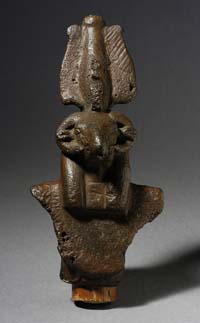
Khnum was a creator god and the god of fertility. He was a potter and the Egyptians believed he molded the cosmic egg that held the sun and humans on his potter’s wheel. Khnum’s worship spread all over Egypt in many forms and some legends called him a god of the Nile. His depictions show him as a man with a ram’s head and in some images he is molding man on a potter’s wheel.
-
Ma'at - The Goddess of Truth and Justice
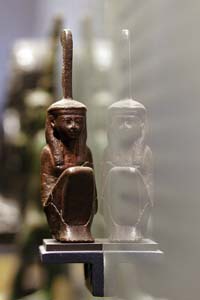
Ma’at was the goddess who personified moral and physical law. She was the counterpart of Thoth and legends called her the “eye of Ra” because she helped guide Ra’s sun boat. Ma’at was the greatest Egyptian goddess because she never changed and she listened to the confessions of the dead. Her images show her as a woman who had a feather on her head, a woman with a feather for a head, or a woman with a feather in her hand.
Click here to discover more about Ma'at
-
Nephthys
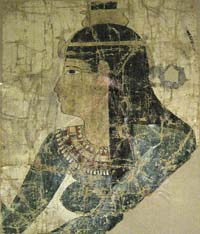
Nephthys was one of the Osirian gods and the personification of darkness, death and decay. She was a friend of the dead and she helped reconstruct Osiris’ body after his murder. Nephthys represented regeneration, reproduction and virility. She was also a symbol of life coming from death. She was a goddess of healing and her depictions show her as a woman wearing the symbol of her name on her head and with long wings.
-
Nun
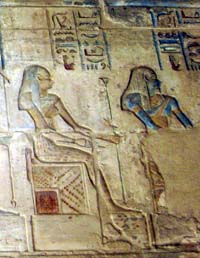
Nun was the celestial waters and his female counterpart was Nanuet. He had no temples dedicated to him or worshippers but his images show him as a man with a frog’s head. Nun’s depictions also showed him as a man with water up to his waist and his arms supporting the other gods. The priests of Hermopolis included Nun in the Ogdoad, the group of eight creator gods.
-
Nut - Goddess of the Sky

Nut was the goddess who personified the sky and she was Geb’s consort and the mother of the Osirian gods. The sycamore was her sacred tree and the Egyptians believed that she gave the dead food. According to legend, Thoth won enough moonlight to create five new days so Nut could give birth to the Osirian gods. Her depictions show her as a woman carrying a vase of water on her head. Other images show her as a woman with stars all over her body which arches over Shu and Geb.
Click here to discover more about Nut
-
Osiris - God of the Underworld

Osiris was one of the Osirian gods and the god of the dead and resurrection. His cult was one of the greatest in Ancient Egypt. According to some myths, Osiris was a human who was later deified and the Egyptians saw him as a person who defied death. After Seth killed Osiris, Anubis embalmed him and he became the god of the dead. His depictions show him as a mummy (sometimes with blue skin) holding the crook and flail as emblems of his kingship.
Click here to discover more about Osiris
-
Ptah
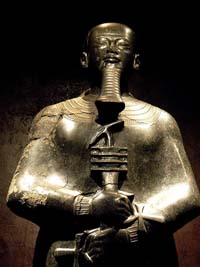
Ptah was the protector of artists and artisans and a craft-god. According to some myths, he used his skills as a metal smith to fashion the other gods. Ptah’s worship was in Memphis and he formed a Triad with his consort Sekhmet and their son Nefertem. Priests regard the Apis bull as the living image of Ptah and it lived in the temple at Memphis. His images show him as a man wearing a tight cam and garment.
-
Ra

Ra was a sun god and some myths claimed that he created everything. He traveled through the sky in a boat and he was the father and ruler of the gods. Ra’s depictions show him as a man with a hawk’s head or as a hawk but both types of images show him wearing a sun disc surrounded by an ureaus. The “son of Ra” was one of Pharaoh’s titles. This title came from the belief that Ra would, at times, sleep with the queen to strengthen the bloodline of the Pharaohs.
Click here to discover more about Ra
-
Ra Horakhty
Ra Horakhty was a composite of the gods Horus and Ra. Horakhty means “Horus of the two Horizons” which referred to the god’s role as the rising and setting sun. Egyptians also believed Ra Horakhty was the sun as it moved across the sky. His depictions show him as a man with a hawk’s head wearing a solar disc and the double crown of Egypt or the ureaus and the Atef crown.
-
Sekhmet
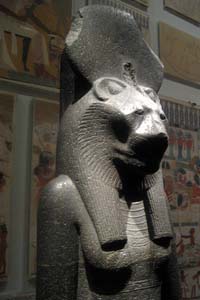
Sekhmet was a lion goddess, the goddess of war and battle, and she personified the destructive heat of the sun. She was in opposition to Bastet and some legends claimed she was an aspect of Hathor. Sekhmet was part of the Memphis Triad with Ptah and Nefertem. Her depictions show her as a woman with a lioness’ head topped by a sun disc surround by the ureaus.
Click here to discover more about Sekhmet
-
Seshat
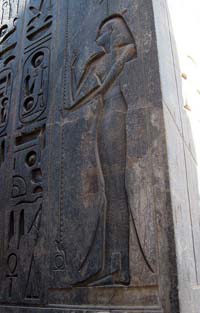
Seshat was the goddess of libraries and literature and the Egyptians associated her with Thoth. Her duty was to write histories and the Pharaohs considered it an honor for her to write about their deeds. One of Seshat’s titles was “the lady of the house of books.” Her images show her as a woman wearing a tight garment made of panther skins and holding a scribe’s palette and writing reed.
-
Seth - God of Chaos
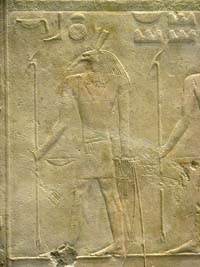
Seth, or Set, was one of the Osirian gods and the god of darkness and evil. He personified darkness, drought and perversity. Seth was the opponent of everything good and life-giving. In some legends, Seth was the adversary of Ra but other legends said he helped protect Ra. Several animals served as symbols for Seth including the black boar, the ass and the crocodile. Red was the color associated with him. Records state that the Egyptians killed some animals with red fur and looked on people with read skin with distrust. His depictions show him as a man with a strange beast’s head.
Click here to discover more about Seth
-
Shu

Shu was the god of air and it was his duty to keep Geb and Nut, his children, separate. His consort was Tefnut and they were the first couple of the Heliopolis Ennead, a group of gods. Some of his images show him as a man wearing one or more feathers on his head and carrying a staff. Other depictions show him as a man with his arms raised and the four pillars of heaven between his arms.
-
Sobek - The Crocodile God of Strength
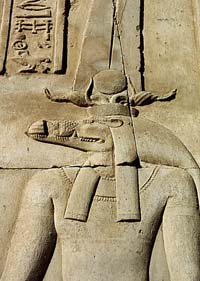
Sobek was the crocodile god and he personified death and evil. The Egyptians feared crocodiles and regarded them as sacred. At Sobek’s temple at Shedet, there was a crocodile that the people saw as the living image of Sobek. It lived in a lake, ate offerings, priests embalmed it after death, and interred it in a special vault. Sobek’s images show him as a man with a crocodile’s head.
Click here to discover more about Sobek
-
Tawaret

Tawaret was the hippopotamus goddess and the patroness of motherhood and childbirth. The common people worshipped her throughout Egypt. Tawaret was also the counterpart of Set and a protector of the dead. Her depictions show her as a female hippo standing on her back legs with a large udder.
-
Tefnut
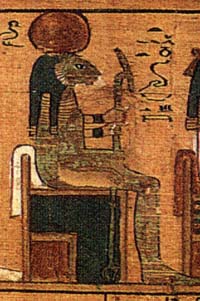
Tefnut was the goddess of moisture and the consort of Shu. She was part of the Great Ennead and helped support the sky. Some legends depict Tefnut as a furious and bloodthirsty lioness. Her images show her as a woman with a lioness’ head topped by a sun disc, by an ureaus or by both.
-
Thoth
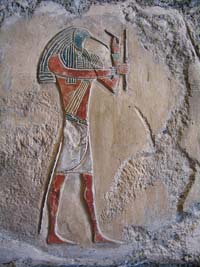
Thoth was a moon god and the patron of the arts, hieroglyphics, science, speech and wisdom. He was also the author of the Book of the Dead and he delivered the final verdict at the trial of a dead soul. Thoth was the writer of all knowledge and he organized the government and religion. He had two sacred creatures; the ibis and the baboon. Thoth’s depictions show him holding a writing reed and a palette. Sometimes, Thoth held the utchat, the symbol of the eye of Ra.
Click here to discover more about Thoth
Click here to discover more about Nephthys
